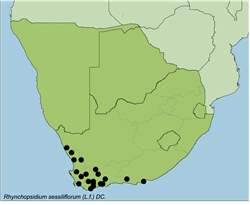Names and synonyms
Rhynchopsidium sessiliflorum (L.f.) DC.= Relhania sessiliflora (L.f.) Thunb.=Athanasia sessiliflora Linne f. =Relhania lateriflora L'Herit. (non Link 1822 p. 340 = Relhania calycina (L.f.) L'Herit. ssp. calycina), nom. superfl.=Rhynchocarpus lateriflorus (L'Herit.) Lessing =Rhynchopsidium sessiliflorum (L.f.) DC. =Rhynchopsidium sessiliflorum (L.f.) DC. var. �. DC.
Derivation of names
Rhynchopsidium: rhunkhos = snout / beak; optos = seensessilis = of a flower or leaf attached directly by its base without a stalk or pedicelfloris = flower
Diagnostic characters
Pappus with barbellate bristles.
Description
Annual herb up to 0.02-0.15(-0.25) m tall. Stems and branches erect or ascending, leafy, glabrous or laxly tomentose and with stalked glands. Leaves glandular-hairy, 5-20 x 0.3-1.3 mm, alternate or sometimes opposite, spreading, slender, mid-ribbed, linear, acute-obtuse, glandular with stalked glands. Capitula about 5 mm diameter, solitary, terminal, sessile or occasionally pedunculate, peduncles up to 8 mm long. Involucre urn-shaped, ovate in outline, 1.5-3 mm wide. Involucral bracts 7-25, outer ovate, inner ovate-oblong with a spreading, brown, scarious apical limb, up to 6 x 2 mm, acute. Receptacle flat, paleate. Paleae lanceolate, canaliculate and marginally flattened and often projected into two lateral teeth, 4.5-6.5 x 0.6-1.2 mm, acute. Ray florets 3-9, tube 1.2-1.8 mm long, with scattered, subulate-triangular hairs; lamina 1.5-2.2 x 0.7-1.3 mm, 4-veined. Disc florets 5-25, perfect. Cypsela narrowly elliptic, 2-3 x 0.4-0.7 mm, � densely villose with apically hooked hairs; more densely villose in ray florets. Pappus crownlike, of � connate scales, up to 0.6 mm long.
Flowering time
Mainly from August to December.
Distribution
Grows on open, sandy or clayey soil on the flats mainly in the southwestern districts, but it extends as far east as Port Elizabeth. It does not go further north than Vanrhynsdorp and Calvinia and is thus absent from Namaqualand. Known from more than 35 specimens.
Habitat
Can be abundant in disturbed clayey, often as a weed, e.g. along roads.
Notes
Related to R. pumilum, but is few-flowered, with urn-shaped capitula, capitula are sessile.Leafless dead plants can remain standing upright for more than a year.
References
ANDERBERG, A.A. & BREMER, K. 1991. Parsimony analysis and cladistic reclassification of the Relhania generic group (Asteraceae - Gnaphalieae). Annals of the Missouri Botanical Garden 78: 1061-1072.BREMER, K. 1976. The genus Relhania (Compositae). Opera Botanica 40.KESTING, D. & CLARKE, H. 2008. Botanical names, what they mean. Wild Flowers of the Cape Peninsula, 3rd revised edition. Friends of Silvermine.VLOK, J. & SCHUTTE-VLOK, A L. 2010. Plants of the Klein Karoo. Umdaus Press
